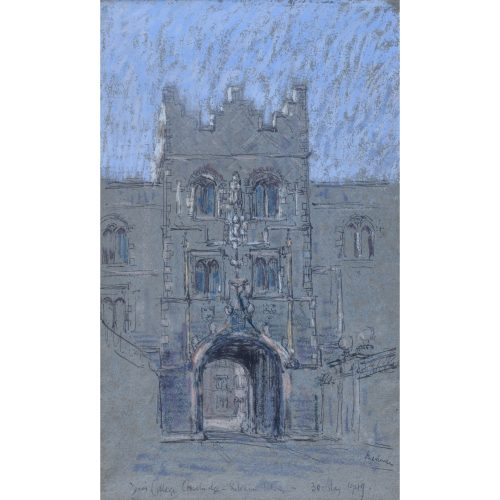-
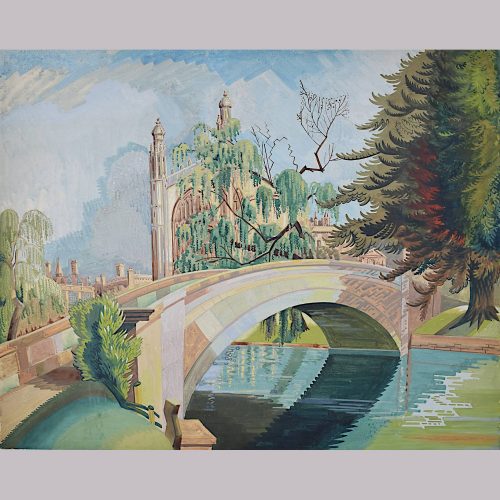
Anonymous King's College Cambridge with the River Cam and Bridge to foreground
51x63.5cm Watercolour Probably 1920s A fine, and large, view of King's College. The artist paints in an art deco style, picking out the stones of the bridge in different colours, the colours all having a heightened sense of reality. Born from cubism, the art deco era is characterised by a fragmented, geometric character particularly evident here. It gives the impression of a shimmering dream. The twenties was an incredible period of change, moving from heavy elaborate styles to a pared back and sleek style expressing more dynamism, an interest in dimension and abstraction. If you are interested email info@manningfineart.co.uk or call us on 07929 749056. -

Richard Henry Wright (1857-1930)
Trinity Great Gate, Cambridge
Watercolour 47x39cm (frame) 25x18cm (9.8×7 inches) Originally from Hampshire, Wright was an artist who specialised in topographical views, mostly in Europe and Egypt. He exhibited at the RA from 1885 to 1913. In 1892 he married the artist Catherine Morris Wood, who also exhibited at the RA – but from 1880 until the 1920s. They lived at 2 Harcourt Buildings in the Inner Temple If you are interested email info@manningfineart.co.uk or call us on 07929 749056. -
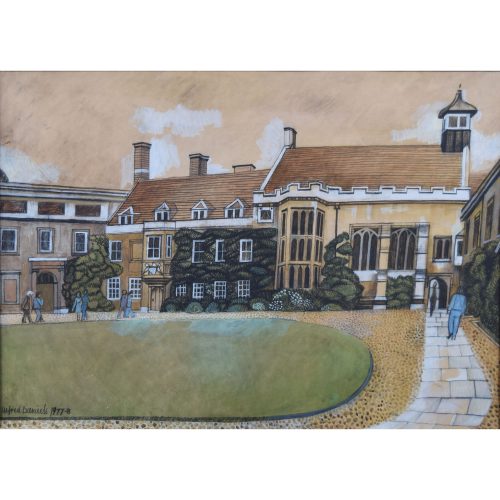
Alfred Daniels RBA RWS (1924-2015)
Christ’s College, Cambridge
Gouache, watercolour and ink on board 40x56cm (15.7×22 inches). In a hand-finished cream frame. Click here for biographical details and other works by the artist. If you are interested email info@manningfineart.co.uk or call us on 07929 749056. -

James Bolivar Manson (1879 - 1945) St John's College, Cambridge
Watercolour 29 x 40 cm Signed lower right. A wintry view of St John's College, Cambridge. The chapel tower nestles behind bare trees, set against a white sky. Manson was an artist who worked at the Tate Gallery and was its Director from 1930 to 1938. His time there was clouded by his frustrated ambitions as a painter and his descent into alcoholism. His professional career began as an office boy - leaving Alleyn's School in Dulwich at 16 - with the publisher George Newnes, and then as a bank clerk. He simultaneously studied painting at Heatherley School of Fine Art, commencing in 1890, and then Lambeth School of Art - much encouraged by Lilian Laugher, a violinist who came to stay in the Manson household. He married her in 1903 - the same year he abandoned his bank job. They moved to Paris for a year. Manson shared a studio with Jacob Epstein, who became a lifelong friend. When they returned to London, Manson joined the Camden Town Group, becoming Secretary. Lilian was a close friend of the Director of the Tate and ensured that Manson, aged 33, became Tate Clerk. Manson continued to paint feverishly at the weekend. The Tate website describes Manson as its 'least succesful' director. Kenneth Clark described him with "a flushed face, white hair and a twinkle in his eye; and this twinkling got him out of scrapes that would have sunk a worthier man without trace." His painting continued to show promise, and he joined the London Group in 1914 and showed with the New England Art Club from 1915. His first solo show was at the Leicester Galleries in 1923 and he became a member of the NEAC in 1927. He attended a dinner at the Hotel George V in Paris in 1938 to celebrate the British Exhibition at the Louvre. Clive Bell wrote to his wife, "Manson arrived at the déjeuner given by the minister of Beaux Arts fantastically drunk - punctuated the ceremony with cat-calls and cock-a-doodle-doos, and finally staggered to his feet, hurled obscene insults at the company in general and the minister in particular, and precipitated himself on the ambassadress, Lady Phipps, some say with amorous intent; others with lethal intent." Bell concluded: "The guests fled, ices uneaten, coffee undrunk... I hope an example will be made, and that they will seize the opportunity for turning the sot out of the Tate, not because he is a sot, but because he has done nothing but harm to modern painting." The Director of the Tate was arbiter as to whether imported items amounted to art (which would make them exempt from customs duty). This caused controversy when Peggy Guggenheim imported sculpture by Marcel Duchamp and others. Manson pronounced Constantin Brâncuși's Sculpture for the Blind (a large, smooth, egg-shaped marble) to be "idiotic" and "not art", and therefore subject to duty. Letters were written to the press and the matter reached the House of Commons, where Manson was criticised and eventually had to back down. He retired at the age of 58. By his own account, "my doctor has warned me that my nerves will not stand any further strain... I have begun to have blackouts, in which my actions become automatic. Sometimes these periods last several hours.... I had one of these blackouts at an official luncheon in Paris recently, and startled guests by suddenly crowing like a cock...." His successor was Sir John Rothenstein, who discovered that the staff referred to artwork in the basement as 'Director's Stock'. It transpired that Manson had been selling it to boost his salary. His work now hangs in the Tate, as well as in many other galleries in Britain and abroad. Condition: Good. If you’d like to know more, please email info@manningfineart.co.uk or call us on 07929 749056. Click here for more views of St John's College, Cambridge. -
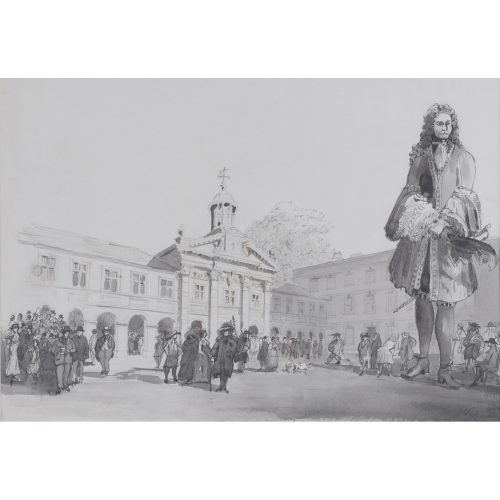
Sir Albert Edward Richardson K.C.V.O., F.R.I.B.A, F.S.A., P.R.A. (1880-1964)
If you are interested, please email info@manningfineart.co.uk or call us on 07929 749056.Cambridge Revisited (1933)
Pen, ink, and wash24 x 35 cmSigned and dated lower right.Renowned for his architectural fantasies, Richardson here depicts Sir Christopher Wren revisiting the chapel he built in 1677. Wren is a Colossus, surveying not only the architecture of the chapel but the fantastical assortment of characters present in the quad. Seventeenth century lords, ladies, and scholars occupy the centre of the picture while 20th century tourists (on the left) watch the scene unfold.Richardson was a leading English architect, teacher and writer about architecture during the first half of the 20th century. He was Professor of Architecture at University College London, a President of the Royal Academy, editor of Architects' Journal, founder of the Georgian Group and the Guild of Surveyors and Master of the Art Workers' Guild. He also received the Architectural Association’s Professor Bannister Fletcher Medal (an award for the study of post- Great Fire London architecture) in 1902. -

John Stanton Ward CBE (1917 - 2007)
St John's College, Cambridge
Watercolour 30 x 47 cm John Stanton Ward CBE was an English portrait artist, landscape painter and illustrator. This view of St John's highlights the dreamlike quality of the college and its city. Ward depicts Cambridge on a winter afternoon; the trees are bare, and the afternoon sun sets gently over the city's lawns and high spires. Condition: very good. -
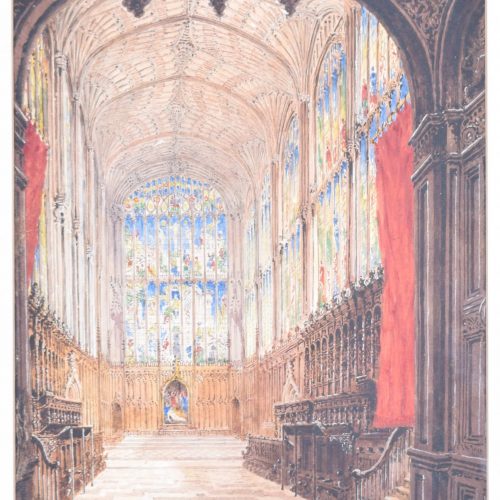
Joseph Murray Ince (1806-1859) King's College Chapel, Cambridge
Watercolour 27.5x21 In a fine hand-finished gilt frame. Provenance (label to reverse) Christopher Wood Gallery Signed lower right 'J M Ince 1844' Brought up in Radnorshire, in Wales, Ince studied under David Cox from 1823-1826, and then exhibited at the Royal Academy. He was a drawing master at Cambridge University during the 1830s, during which period he painted many views of the Colleges of both Oxford and Cambridge, returning to Radnorshire in 1835. His works are in the collections of major galleries including the Tate, The V&A and The Fitzwilliam Museum in Cambridge. This is a particularly fine interior painting of the venue for the famous annual Service of Nine Lessons and Carols. If you are interested email info@manningfineart.co.uk or call us on 07929 749056. Condition: In a fine hand-finished gilt frame. Generally very good condition. -
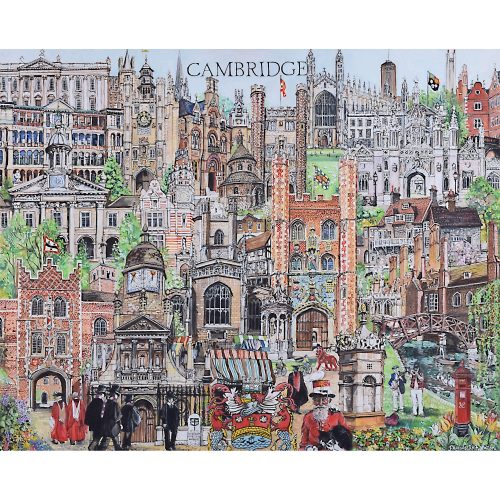
Francess Richardson
Cambridge Capriccio
Gouache on paper c. 1980 43x53cm Framed in hand-finished black frame A Cambridge-based artist who has accumulated all the best features of Cambridge in this one drawing. Originally from Rochdale, she has lived near Cambridge since the mid 1970s. If you are interested email info@manningfineart.co.uk or call us on 07929 749056. -
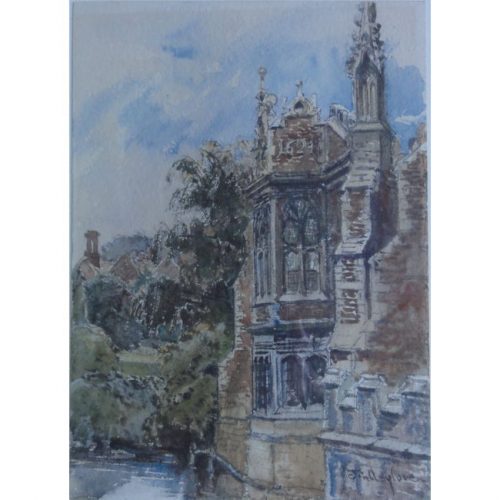
John Fulleylove (1845-1908)
The Old Library, St John’s College, Cambridge
Signed lower right “Fulleylove” Watercolour 19x13cm (7×5 inches) Please click here for the matching watercolour of the Kitchen Bridge together with biographical details and other works by the artist. If you are interested email info@manningfineart.co.uk or call us on 07929 749056. -
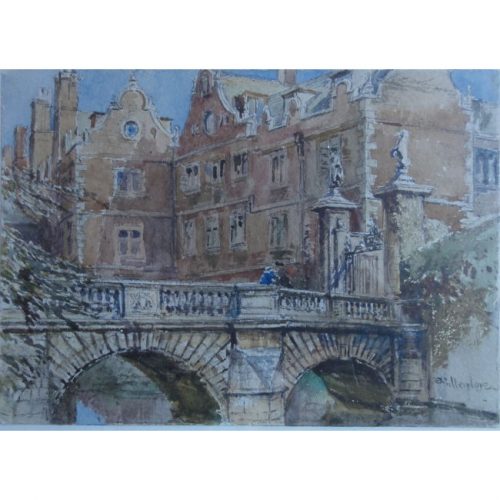 John Fulleylove (1845-1908) The Kitchen Bridge, St John’s College, Cambridge Signed lower right “Fulleylove” Watercolour 13 x 19cm (5 x 7 inches) Please click here for the matching watercolour of the Old Library together with biographical details and other works by the artist. If you are interested email info@manningfineart.co.uk or call us on 07929 749056.
John Fulleylove (1845-1908) The Kitchen Bridge, St John’s College, Cambridge Signed lower right “Fulleylove” Watercolour 13 x 19cm (5 x 7 inches) Please click here for the matching watercolour of the Old Library together with biographical details and other works by the artist. If you are interested email info@manningfineart.co.uk or call us on 07929 749056. -
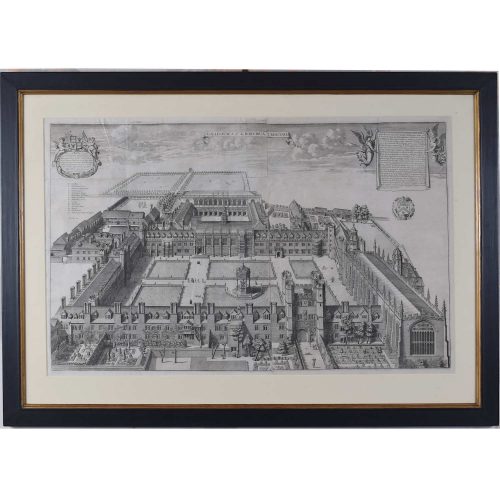
David Loggan (1634 - 1692)
Trinity College, Cambridge (1690)
Engraving 80 x 50 cm Loggan was born to English and Scottish parents, and was baptised in Danzig in 1634. After studying engraving in Danzig with Willem Hondius (1598-1652 or 1658), he moved to London in the late 1650s, going on to produce the engraved title-page for the folio 1662 Book of Common Prayer. He married in 1663 and moved to Nuffield in Oxfordshire in 1665. Loggan was appointed Public Sculptor to the nearby University of Oxford in the late 1660s, having been commissioned to produce bird’s-eye views of all the Oxford colleges. He lived in Holywell Street as he did this. The 'Oxonia Illustrata' was published in 1675, with the help of Robert White (1645 - 1704). Following its completion, Loggan began work on his equivalent work for Cambridge; the 'Cantabrigia Illustrata' was finally published in 1690, when he was made engraver to Cambridge University. The 'Oxonia Illustrata' also includes an engraving of Winchester College (Winchester and New College share William of Wykeham as their founder) whilst the 'Cantabrigia Illustrata' includes one of Eton College (which shares its founder, Henry VIII, with King’s College). Bird’s-eye views from this era required a particular talent as an architectural perspectivist; it was not until 1783 that it became possible for artists to ascend via hot air balloons and view the scenes they were depicting from above. Loggan thus had to rely on his imagination in conceiving the views. Loggan’s views constitute the first accurate depictions of the two Universities, in many ways unchanged today. Whilst the Oxford engravings were produced in reasonable numbers and ran to a second edition by Henry Overton (on thicker paper and with a plate number in Roman numerals in the bottom right-hand corner), those of Cambridge were printed in much smaller numbers. The Dutchman Pieter van der Aa published some miniature versions of the engravings for James Beverell’s guidebook to the UK, 'Les Delices de la Grande Bretagne' (circa 1708). The contemporary artist Andrew Ingamells has produced a highly-acclaimed series of etchings which bring Loggan’s original vision up to date. Condition: generally very good; printed on two sheets, folds as issued. A few creases to top area. As a multi-folded plate in the published book, Trinity has normally suffered and is normally trimmed closely and has damage; this particular example has instead good margins outside the platemark and without damage to the folds. A very good copy of Trinity. If you’d like to know more, please email info@manningfineart.co.uk or call us on 07929 749056. -
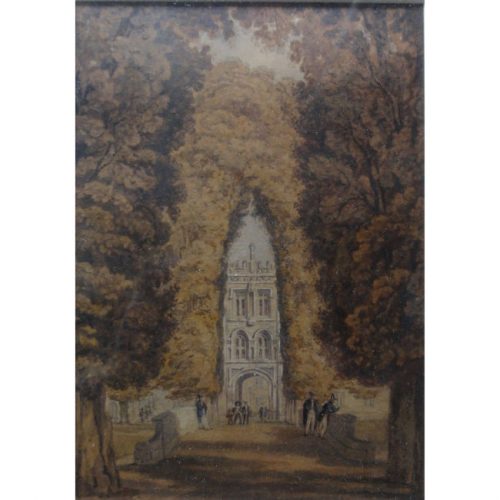
James Sargant Storer (1771–1853)
Trinity College Gateway from The Backs, Cambridge, c1820
Watercolour 19×13.5cm (7.4×5.3 inches) unframed This is the original watercolour for an engraving published as The Avenue by James & Henry Storer c.1820 in Delineations of Trinity College. The exquisitely detailed watercolour showing academical figures standing on Trinity Bridge as viewed from the backs is framed in its original nineteenth century gilt slip behind nineteenth century glass. Provenance: by decent from the artist. Storer was a topographer with an interest in ancient architecture, making drawings and engraving the plates himself. From 1814 he worked in conjunction with his eldest son, Henry, who predeceased him in 1837. They were buried next to each other at St James’s Chapel in Pentonville, now Joseph Grimaldi Park (named after the clown, Grimaldi who was buried there in 1837 and whose railed grave remains to this day). If you are interested email info@manningfineart.co.uk or call us on 07929 749056. -

George Pyne (1800-1884)
Great Court, Trinity College, Cambridge
Signed G Pyne 1850 Watercolour 20.5 x 29 cm (8 x 11.5 in.) It appears Pyne spent some time painting in Cambridge in 1849-50. This is - for Pyne - an unusually large composition; a fine watercolour of Trinity Great Court, with King’s College chapel in the background and elegant figures in the court. It is a particularly pleasing composition. Click here for biographical details and other works by the artist. If you are interested email info@manningfineart.co.uk or call us on 07929 749056. -
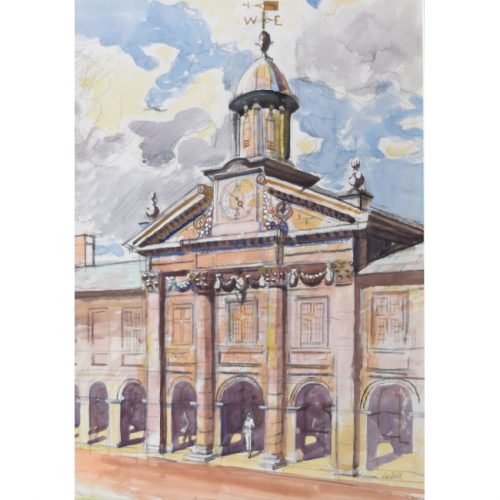 Edwin La Dell ARA (1914-1970) Emmanuel College Cambridge Signed Watercolour
Edwin La Dell ARA (1914-1970) Emmanuel College Cambridge Signed Watercolour46x32cm (18.11 X 12.6 in)
In fine original hand-finished painted frame.
Click here for biographical details and other works by the artist. If you are interested email info@manningfineart.co.ukor call us on 07929 749056. -
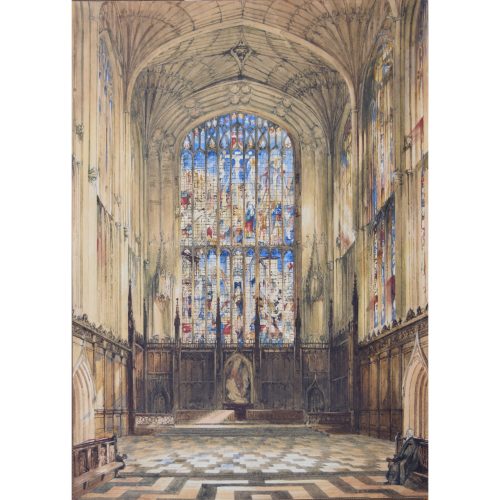
John Anderson Bell (1809-1865)
King's College Cambridge Chapel Interior
Signed and indistinctly dated Watercolour c. 1840 53x39cm Bell was born in Glasgow; his father was James Bell, advocate and his sister Jane Cross Simpson the hymn-writer and poet. Following Edinburgh University Bell spent 1829 and 1830 in Rome as an art student, returning to the UK to serve his articles as an architect with Rickman & Hutchinson, the gothic revivalist practice in Birmingham. Subsequently he practised in Edinburgh, designing country houses, and the Victoria Buildings in Glasgow for the Conservative politician Archibald Orr Ewing in Scottish baronial style. Thirty of the engravings in John Le Keux's magnificent 1847 book Memorials of Cambridge are from paintings by Bell; this particular painting is believed to have been painted at the same time, although not published. The Great East Window depicted in the painting was created between 1526 and 1531 by Gaylon Hone and three partners (one Flemish and two English) and - together with the other sixteen they made - represent some of the finest stained glass of their period. Here Bell has captured the colours and the light of the window in almost magical fashion. It is an interesting view as it records the chapel in the mid nineteenth century. In 1968 the installation of Rubens' the Adoration of the Magi as an altarpiece involved the lowering of the Sanctuary floor through removal of the steps clearly visible in Bell's view and also removal of the seventeenth century panelling around the walls. It is still felt that the chapel would have been better left 'unimproved' and without the Reubens, though the form recorded by Bell had itself been improved in 1906 when Detmar Blow designed a reredos. Blow's reredos remains in storage in the College. The East window may be viewed in high resolution in the series of seven short films - accompanied by music by King's alumnus Francis Grier - entitled Sword in the Soul. -
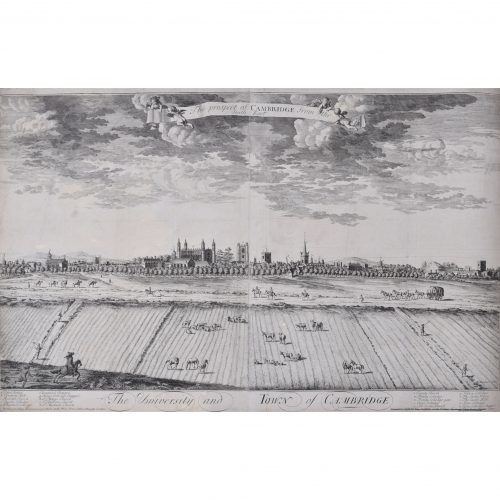
Johannes Kip (1652 - 1722) after R Whitehand
Prospect of Cambridge from the South East (1724)
Engraving 57 x 88 cm A view of the city of Cambridge, replete with college spires, by Johannes ''Jan'' Kip, the Dutch draughtsman, engraver and print dealer. The engraving illustrates an 18th century Cambridge defined by livestock and farmhands, as well as its University. The largest and best view of Cambridge, extremely rare - we have not traced any other copies at auction. Condition: good. Previously folded, occasional small losses and the odd slightly toned patch; two joined sheets. Trimmed to within platemark; very rare. If you’d like to know more, please email info@manningfineart.co.uk or call us on 07929 749056. -
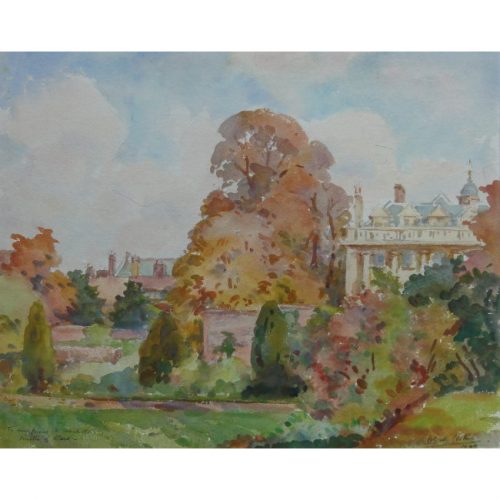
Wilfred Gabriel de Glehn RA (1870-1951)
Clare College from the Backs
Watercolour Inscribed “To my friend H Thirkill Master of Clare” Signed “W de Glehn, 1940” 40x50cm De Glehn painted Henry Thirkill in a portrait that is in the collection of Clare College and may be viewed here. Thirkill was Master between 1939 and 1958 and the portrait was commissioned in 1947. A versatile painter, skilled at portraiture, landscapes and figures de Glehn is regarded as one of England’s premier Impressionist painters. His ability to portray lighting in a lively fashion and his vibrant use of colour combine to provide wonderfully rich paintings. If you are interested email info@manningfineart.co.uk or call us on 07929 749056. -
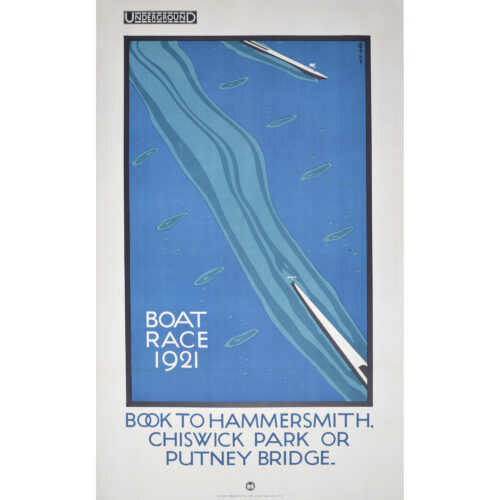
Charles Paine (1895 - 1967)
Boat Race 1921
Lithograph 102 x 64 cm Signed upper right in plate. Charles Paine's iconic 1921 poster encourages the use of the London Underground in order to view the Boat Race. The slick design features one boat’s stern disappearing from the frame and the other boat’s bow entering it (Cambridge won that year), alongside a strikingly Art Deco typeface. Charles Paine was a versatile and prolific designer, who drew on his training in stained glass to create bold, structured and highly stylised lithographs for a variety of companies. This decorative and brightly-coloured map illustrates the various county regiments of Great Britain, with a border of regimental badges. Condition: backed to linen; excellent, two small areas of repair to margin (invisible); hint of old folds. If you are interested, please email info@manningfineart.co.uk or call us on 07929 749056. Click here for other Boat Race pictures.

